A place to realise parenthood dream
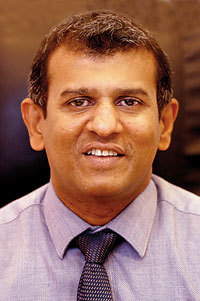
Dr. Lasantha Karunasekera
Walking in through a broad corridor or stepping in straight off the elevator, it is a different world that one enters……..a world of warm pink, with a tiny pair of baby shoes portrayed on the wall giving a pointer to what it is.
It is the state-of-the-art Fertility Centre on the first floor of the Hemas Hospital in Wattala, away from the hustle and bustle of other consultation areas.
Every little detail has been considered to make this Fertility Centre not only comfortable and cozy but also to provide sophisticated support for all those couples who are craving to find fulfilment of the most basic of needs……..parenthood and the joy of holding a bouncy baby in their arms!
It is this month (April) that the Fertility Centre gets down to serious work such as In-vitro Fertilization (IVF) and Intracytoplasmic Sperm Injection (ICSI), with all the facilities in place. It had its soft opening in February, having begun with Intrauterine Insemination (IUI) and sperm-freezing.
The donor programmes for both sperm and egg (ova) are in the pipeline, MediScene learns.
“We will offer Fertility Evaluation to couples or individuals who wish to get themselves screened to find out their fertility status,” says Clinical Embryologist Dr. Thilina S. Palihawadana.
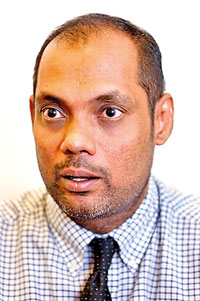
Dr. Thilina Palihawadana
For those who seek fertility treatment, a multi-disciplinary and holistic approach will be the core of our service, reiterates Dr. Palihawadana, citing the example of a woman who is unable to conceive due to endometriosis, polyps or fibroids protruding into the uterus (womb). “We will then provide minimal access procedures such as laparoscopy or hysteroscopy.”
Laparoscopy is keyhole surgery using small cuts in the abdomen, as opposed to a large abdominal incision and is a common procedure to diagnose and remove mild to moderate endometriosis. Hysteroscopy, in which a thin lighted tube is inserted through the vagina, is used to examine the cervix and the interior of the uterus and comes in handy for polyps and fibroids, it is understood.
Another service provided by the Fertility Centre for males, meanwhile, will be Computer-Aided Semen Analysis (CASA).

A 3D pelvic ultrasound scan being performed. Pix by M.A. Pushpa Kumara
A walk-through the Fertility Centre, guided by Dr. Palihawadana and the Director General Manager of Hemas Hospital, Wattala, Dr. Lasantha Karunasekera, reveals all – a comfortable waiting room; a dedicated, fully-equipped theatre; an IVF laboratory attached to the theatre; a mastabatorium with TV and a comfortable couch; an andrology laboratory; cryobank with freezing facilities; and a micro-manipulator for ICSI and embryo-biopsy facilities.
Pointing out the thought given to detail, Dr. Palihawadana says that while the IVF laboratory which is the “heart” of the Fertility Centre and the theatre have walls of bio-clad, an inert material not harmful or toxic and easy to clean, special floors and ceilings, there is a lot of stainless steel as well. The theatre is equipped with an anaesthetic machine and an ultrasound scanner.
The air-flow is properly designed to maintain the quality of air while the incubators are high-end and the IVF lab size has been kept to a bare minimum. Once the eggs are extracted from the potential mother, there is no walking around, carrying them. They will be passed immediately through a channel heated to that of a human’s body temperature, with the bed-to-IVF-chamber distance being very short, he says.
The heat in the theatre and the IVF lab is also maintained at the body temperature of humans to make sure that the eggs are unharmed. This is because the quality of the environment influences the success rate of Assisted Reproductive Technology (ART), says Dr. Palihawadana, pointing out that the air-handling unit which would regulate the environment is half the size of the IVF lab.
The Fertility Centre is designed in such a way to stringently prevent the air-flow moving from an unclean environment to the clean environment within it, he stresses.
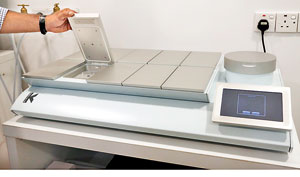
A bench-top incubator for embryos to grow and (right) the linen shute from the theatre
The air-handling unit is fully-automated and connected to the automated Building Maintenance System which would send out alarms if the carbon dioxide (CO2) levels rise, says Dr. Karunasekera.
MediScene also sees simple measures such as a linen-duct straight from the theatre so that handling of dirty linen is minimal and an IVF closet with different bar-codes. There is no need to touch door handles as the doors operate on sensors, opening and shutting silently.
Dr. Palihawadana points out that all services are under one roof – investigations, administration of drugs, scanning and consultations – it’s a one-stop centre and the couples do not have to undergo any embarrassment in trying to get their medical requirements from elsewhere. Absolute confidentiality is also assured.
There is a dedicated staff – a coordinator, nurses, other assistants and technical staff – with each member assigned a specific role and all sensitized about their duties and the needs of the patients. The model is that everybody will also know what the other person’s duty is and be aware of the patient’s needs.
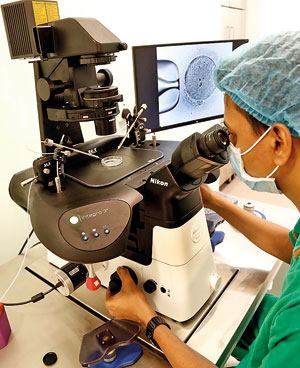
In the IVF Laboratory – A technical staff member at the micro-manipulator used for ICSI and embryo biopsies
Referring to the technical staff, Dr. Palihawadana says that even though Sri Lanka has been offering fertility services for about 20 years, a major lack is training for technical staff such as those doing seminal fluid analysis.
This is another lacuna that the Fertility Centre hopes to fill by launching research and training facilities, MediScene understands.
Dr. Karunasekera focuses on the vision of the Hemas Group of Hospitals to provide affordable healthcare, enriching the lives of people.
“It is in pursuit of this that we looked outside Colombo city and set up the Hemas Hospital in Wattala in 2008 followed by the Hemas Hospital in Thalawathugoda in 2013.
Initially, Hemas Hospital Wattala provided primary and secondary care with Physicians, Obstetricians & Gynaecologists, Surgeons and Paediatricians, along with a few other specialties and Outpatient Department (OPD) services for all specialties. When we evaluated our services later, we found that there were gaps and people were going to Colombo seeking surgical facilities,” says Dr. Karunasekera, pointing out that it was then that they added more such as gastroenterology, orthopaedics, cosmetics, urology, neurology, ear-nose-throat (ENT). “We also enhanced the model of the hospital. Earlier there were only visiting consultants but now there are 24/7 services at this 130-bed hospital with a mix of permanent and visiting consultants.”
He says: “We were the first private hospital chain to secure international accreditation in 2011 and also get re-accredited in 2015. Our core values are built on the three pillars of clinical excellence, customer experience and innovation.”
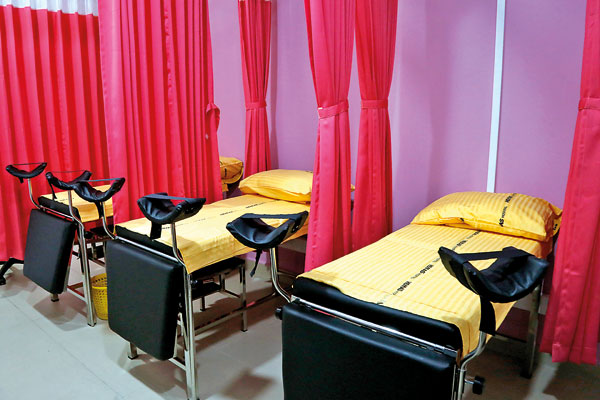
The IUI procedure room
“We provide all services that the city hospitals do except cardiology interventions. We do have diagnostic cardiology CT,” he says, adding that another area they focused heavily on is maternity and child care, which is on par with the city. With the obstetric practice being large at the hospital, they realized that 1 in 5 couples in the general population had some issue in conceiving. Then they decided to go down the pathway of introducing ART on the firm foundation that they would give of their best to the patients, ethically and in a transparent manner.
“There would be no short-cuts. A well-built Fertility Centre on par with international standards, with advice from experts in Australia who will continue to guide them,” he says.
Conceding that regulations in the field of fertility need to be established, Dr. Palihawadana underscored that they will have self-regulation and set standards. “If we do it right, others will follow. We will be transparent, giving both the success and failure rates. Full transparency is our motto and then the public can make an informed decision.”
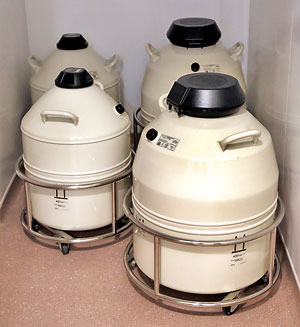
The cryo-bank for sperm, egg and embryo freezing
Going by western standards, the Fertility Centre will strive to provide a holistic approach, he says. This holistic approach will include the care of a multi-disciplinary team not only the services of an Obstetrician and Gynaecologist and Embryologist, but also a Physician, Surgeon, Psychologist along with nutrition therapy and the legal aspects.
The fine-tuning is being done now at the Fertility Centre, while already they have embarked on 250 IUI procedures.
“Quality assurance and key performance indicators are in place,” assures Dr. Palihawadana.
| Treating infertility The Assisted Reproductive Technology that is used to treat infertility includes:
Sometimes men would freeze their sperm if undergoing medical treatment that may interfere with their fertility, including a vasectomy (surgical procedure for male sterilization) and chemotherapy or radiation for cancer. | |


